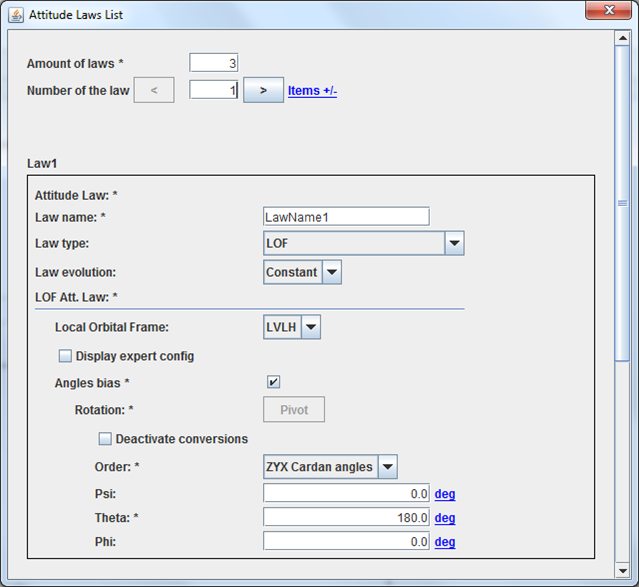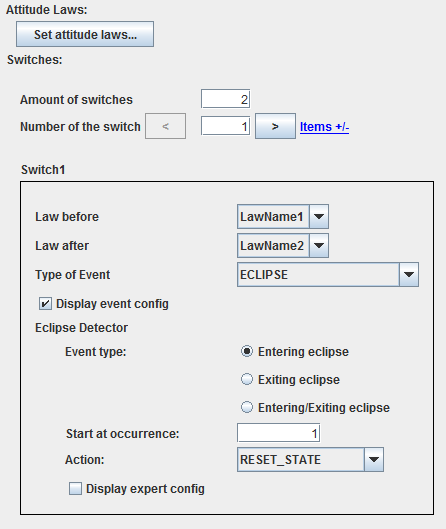GPAttitudeSequence : Différence entre versions
De Wiki
(Page créée avec « == How to call it == For using the <font color=#4169E1>GPAttitudeSequence</font> class the developer has only to create such an object with these two possibilities: * Wi... ») |
|||
| Ligne 3 : | Ligne 3 : | ||
For using the <font color=#4169E1>GPAttitudeSequence</font> class the developer has only to create such an object with these two possibilities: | For using the <font color=#4169E1>GPAttitudeSequence</font> class the developer has only to create such an object with these two possibilities: | ||
| − | * With just a boolean to tell if the switches will be displayed one below the other (false) one or just one by one (true) | + | * With just a '''boolean''' to tell if the switches will be displayed one below the other ('''false''') one or just one by one ('''true''') |
<syntaxhighlight lang="java"> | <syntaxhighlight lang="java"> | ||
| Ligne 16 : | Ligne 16 : | ||
attSeq = new GPAttitudeSequence(date0, false); | attSeq = new GPAttitudeSequence(date0, false); | ||
</syntaxhighlight> | </syntaxhighlight> | ||
| + | |||
| + | == Display == | ||
| + | |||
| + | === Reference date === | ||
| + | |||
| + | First, the user will have to select a reference date. There are two possibilities: | ||
| + | * “'''custom'''”: a specific date will be entered by the user | ||
| + | * “'''external'''”: in that case no modification of the date is available as it corresponds to the date initially defined (note that this date may be automatically updated if the initial orbit date is modified). | ||
| + | |||
| + | [[File:ReferenceDate.png]] | ||
| + | |||
| + | === Listof attitude laws === | ||
| + | |||
| + | Then, a button appears that allows displaying a new window to define a set of available attitude laws. Each law is defined as below: | ||
| + | * Name of the law | ||
| + | * Type of the law (local orbital frame (<font color=#FF8C00 title="Local Orbital Frame">LOF</font>), inertial, sun pointing …) | ||
| + | * Law evolution (constant or spinned) | ||
| + | * Then data linked to the type of law. As an example for <font color=#FF8C00 title="Local Orbital Frame">LOF</font> attitude law, the user will have to select which <font color=#FF8C00 title="Local Orbital Frame">LOF</font> to take into account and eventually angle bias. | ||
| + | |||
| + | [[File:GPAttitudeSequenceLawsList.png]] | ||
| + | |||
| + | === Sequence === | ||
| + | |||
| + | At last, the user will get a choice between: | ||
| + | * A simple attitude sequence with only a single law chosen in the previous list (not available in V1.2.1 version) | ||
| + | * A more sophisticated definition of the attitude sequence using the PATRIUS “event switch” possibility. The user will have to define one or several switches defined by the following data: | ||
| + | ** The attitude law before the event (taken in the previous list) | ||
| + | ** The attitude law once the event occurred (taken in the previous list) | ||
| + | ** The type of event and data related to it. | ||
| + | This “event switch” is a very powerful option that allows defining relatively shortly a whole mission. For example, if we want to define the fact that the vehicle is <font color=#FF8C00 title="Local Vertical Local Horizontal">LVLH</font> oriented in eclipse and Sun pointing out of eclipse, we will only have to define two switches calling to two attitude laws: | ||
| + | ** Switch #1 with entering in eclipse as orbital event and law before "Sun pointing" and law after "LVLH" | ||
| + | ** Switch #2 with exiting in eclipse as orbital event and law before "<font color=#FF8C00 title="Local Vertical Local Horizontal">LVLH</font>" and law after "Sun pointing" | ||
| + | |||
| + | [[File:GPAttitudeSequence.png]] | ||
Version du 29 juillet 2017 à 12:06
How to call it
For using the GPAttitudeSequence class the developer has only to create such an object with these two possibilities:
- With just a boolean to tell if the switches will be displayed one below the other (false) one or just one by one (true)
attSeq = new GPAttitudeSequence(false);
- Or with an additional parameter that corresponds to an absolute date which will be used as a reference date (for relative positioning of attitude laws).
AbsoluteDate date0 = new AbsoluteDate(2010, 1, 1, TimeScalesFactory.getUTC()); attSeq = new GPAttitudeSequence(date0, false);
Display
Reference date
First, the user will have to select a reference date. There are two possibilities:
- “custom”: a specific date will be entered by the user
- “external”: in that case no modification of the date is available as it corresponds to the date initially defined (note that this date may be automatically updated if the initial orbit date is modified).
Listof attitude laws
Then, a button appears that allows displaying a new window to define a set of available attitude laws. Each law is defined as below:
- Name of the law
- Type of the law (local orbital frame (LOF), inertial, sun pointing …)
- Law evolution (constant or spinned)
- Then data linked to the type of law. As an example for LOF attitude law, the user will have to select which LOF to take into account and eventually angle bias.
Sequence
At last, the user will get a choice between:
- A simple attitude sequence with only a single law chosen in the previous list (not available in V1.2.1 version)
- A more sophisticated definition of the attitude sequence using the PATRIUS “event switch” possibility. The user will have to define one or several switches defined by the following data:
- The attitude law before the event (taken in the previous list)
- The attitude law once the event occurred (taken in the previous list)
- The type of event and data related to it.
This “event switch” is a very powerful option that allows defining relatively shortly a whole mission. For example, if we want to define the fact that the vehicle is LVLH oriented in eclipse and Sun pointing out of eclipse, we will only have to define two switches calling to two attitude laws:
- Switch #1 with entering in eclipse as orbital event and law before "Sun pointing" and law after "LVLH"
- Switch #2 with exiting in eclipse as orbital event and law before "LVLH" and law after "Sun pointing"


